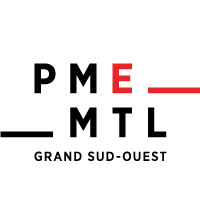And you’re off! You’re launching your own business. There are hundreds of things to plan, problems to solve and ideas to develop. Somewhere in this whirlwind of activity, you have to create your brand image. Where should you start?
Key aspects of business branding
Your brand image sums up your business, its niche and personality at a glance. It’s a visual message, reflected throughout the whole customer experience: from your logo to your corporate colours, and including the font you use, your business cards, packaging, promotional items and brochures, and of course your online presence.
First of all: your business name. It’s at the heart of your brand image, conveyed graphically and in every context.
Sasha Bastien chose Cycles B for his mobile bicycle repair shop in Montréal. “I used ‘Cycles’ because most bicycle-related stores use it. I thought that customers would appreciate the familiarity. The letter B represents my family name. It’s a short, snappy business name, easy to remember.”

For Véronique Richard, the process took more time. “To start with, I came up with a different name for my studio where I design and produce useful little decorative items. But every time I mentioned it to anyone, I didn’t feel comfortable with it. I finally realized that it just wasn’t the right name. Then I came across the word ‘ARCHIPEL’ and just fell in love with it. It was important to me that my business name represent my vision. If I ever have any doubts, I come back to that word and remember what it means: small interconnected objects, the idea of a series, creative islands… and it makes me feel better.”

Your business cards are also a key promotional tool. They give customers your basic information, and are often the first way of communicating your business image. They’re easy to carry around, and inexpensive to produce. You can convey a distinctive image without being extravagant. For instance, ARCHIPEL chose to make a series of cards in several different styles. Each card shows a drawing that appears on the company’s different items. It’s a good way to pique customers’ curiosity and invite them to take a closer look at the business.
Designing your brand identity: Should you ask for help?
If you want a strong identity for your business, you should ask an expert. Unless you have the technical skills yourself, or lots of time to waste on trial and error, I recommend that you call on the professionals. Sasha agrees wholeheartedly: “I approached a friend who works in the field. He asked me to choose a name. A week later, he showed me five logos. I picked one. Then he designed seven mock-ups. I chose the one I liked best. It was a really simple process. Working with a pro is a must!”
Véronique, whose firm does design and printing, had the skills for designing her logo herself. She adds: “People sometimes say that being an entrepreneur is about improvising, and that’s sort of true in my case. I spend a lot of time thinking about things that sometimes seem pointless in the moment, but when it comes time to move, I know where I’m going. That’s what I did with my branding.”
If graphic design isn’t your cup of tea, like Sasha, there may well be some creative people in your network who have the tools to translate the soul of your business into an image.
Consistency is key
A brand image needs to be applied consistently. At ARCHIPEL, for instance, all its products are marked with simple lines. Its cards are printed in black – an inexpensive and versatile choice, since ARCHIPEL is not associated with any specific colour. This means that it can add a touch of colour whenever it wants, to suit the season and its current collections.
ARCHIPEL also uses postcards (initially designed for children) that adult customers can colour in as they like. It’s an original way to get customers involved, and to include more information on the back of the card.
Sasha, for his part, wants to invest in small, inexpensive promotional items: “With stickers and t-shirts, customers themselves will be publicizing my logo, and they can talk about their experience.”
Strengthening customers’ connection with your brand
A company’s brand is communicated in all kinds of small details. At Cycle B, for instance, it’s all summed up in the company’s truck, carefully designed and perfectly integrated with its corporate identity.
It can also be something as simple as a little thank you card after a purchase, or the packaging that’s so perfect you’d almost like to frame it. Think of small items bearing your logo and related to your goods or services, like the water bottle with a spa’s name and logo that customers are proud to carry around afterward.
Items like this extend your customers’ after-service experience, in terms of both time and quality.
ARCHIPEL offers a notebook display case that it loans to stores to showcase its products. It’s a promotional tool that makes the company’s product more accessible, showing how it can be used at home or in the office.
In short…
Your company’s identity is conceived with its name, is born through its logo, and grows through its colours, fonts and displays. It lodges itself in customers’ minds thanks to the many ways it is expressed and improves the quality of the customer experience.
You haven’t given any thought to your brand image yet? Then get ready, set, create! Come up with a whole world that will be an oasis for your customers, one they’ll want to return to again and again!
Many thanks to Sasha and Véronique for their valuable input for this article.
--
This article was written by Isabelle Paille, brand image expert, sales and marketing advisor-trainer, École des entrepreneurs | MTL
